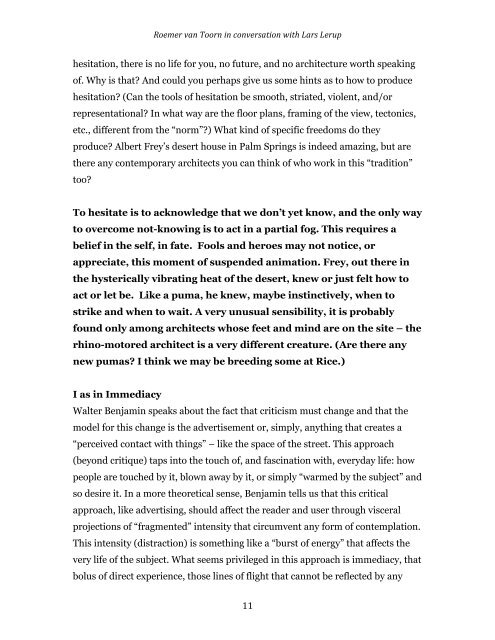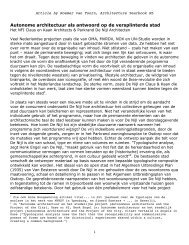ABCD Lars & Roemer
ABCD Lars & Roemer
ABCD Lars & Roemer
Create successful ePaper yourself
Turn your PDF publications into a flip-book with our unique Google optimized e-Paper software.
<strong>Roemer</strong> van Toorn in conversation with <strong>Lars</strong> Lerup <br />
hesitation, there is no life for you, no future, and no architecture worth speaking<br />
of. Why is that? And could you perhaps give us some hints as to how to produce<br />
hesitation? (Can the tools of hesitation be smooth, striated, violent, and/or<br />
representational? In what way are the floor plans, framing of the view, tectonics,<br />
etc., different from the “norm”?) What kind of specific freedoms do they<br />
produce? Albert Frey’s desert house in Palm Springs is indeed amazing, but are<br />
there any contemporary architects you can think of who work in this “tradition”<br />
too?<br />
To hesitate is to acknowledge that we don’t yet know, and the only way<br />
to overcome not-knowing is to act in a partial fog. This requires a<br />
belief in the self, in fate. Fools and heroes may not notice, or<br />
appreciate, this moment of suspended animation. Frey, out there in<br />
the hysterically vibrating heat of the desert, knew or just felt how to<br />
act or let be. Like a puma, he knew, maybe instinctively, when to<br />
strike and when to wait. A very unusual sensibility, it is probably<br />
found only among architects whose feet and mind are on the site – the<br />
rhino-motored architect is a very different creature. (Are there any<br />
new pumas? I think we may be breeding some at Rice.)<br />
I as in Immediacy<br />
Walter Benjamin speaks about the fact that criticism must change and that the<br />
model for this change is the advertisement or, simply, anything that creates a<br />
“perceived contact with things” – like the space of the street. This approach<br />
(beyond critique) taps into the touch of, and fascination with, everyday life: how<br />
people are touched by it, blown away by it, or simply “warmed by the subject” and<br />
so desire it. In a more theoretical sense, Benjamin tells us that this critical<br />
approach, like advertising, should affect the reader and user through visceral<br />
projections of “fragmented” intensity that circumvent any form of contemplation.<br />
This intensity (distraction) is something like a “burst of energy” that affects the<br />
very life of the subject. What seems privileged in this approach is immediacy, that<br />
bolus of direct experience, those lines of flight that cannot be reflected by any<br />
11






